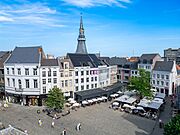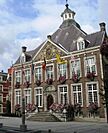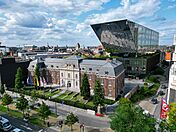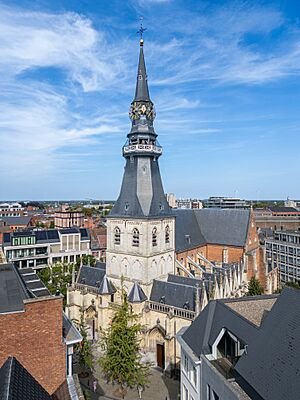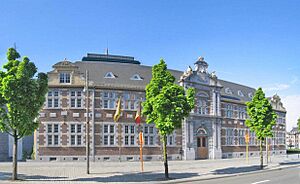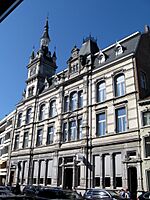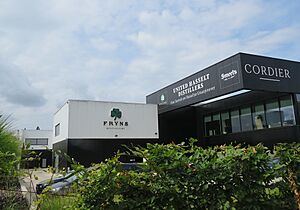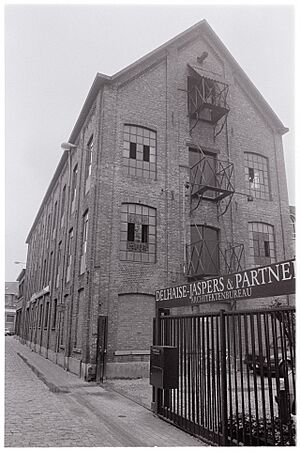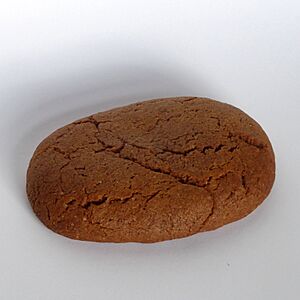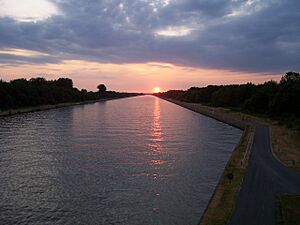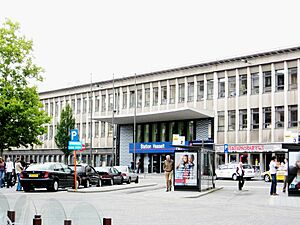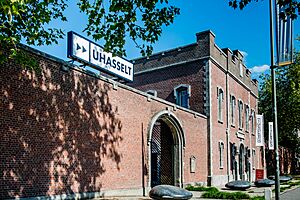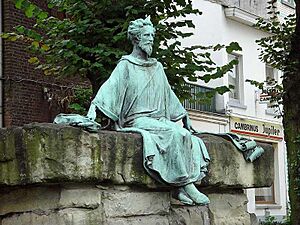Hasselt facts for kids
Quick facts for kids
Hasselt
|
|||
|---|---|---|---|
|
From left to right, top to bottom: City center with St. Quentin's Cathedral in the bottom left, Grote Markt, timber-framed house Het Sweert, Old City Hall, New City Hall
|
|||
|
|||
| Country | Belgium | ||
| Community | Flemish Community | ||
| Region | Flemish Region | ||
| Province | Limburg | ||
| Arrondissement | Hasselt | ||
| Area | |||
| • Total | 102.24 km2 (39.48 sq mi) | ||
| Population
(2018-01-01)Lua error in Module:Wd at line 1575: attempt to index field 'wikibase' (a nil value).
|
|||
| • Total | Lua error in Module:Wd at line 1,575: attempt to index field 'wikibase' (a nil value). | ||
| Postal codes |
3500, 3501, 3510, 3511, 3512
|
||
| Area codes | 011 | ||
| Website | www.hasselt.be | ||
|
|
|||
Hasselt is a city and a local government area (called a municipality) in Belgium. It is the main city and capital of the province of Limburg. This province is part of the Flemish Region, which is the Dutch-speaking northern part of Belgium.
As of August 2023, Hasselt had about 80,846 people living there. The old part of Hasselt is surrounded by smaller towns and villages like Kiewit and Runkst. Other nearby areas that are now part of Hasselt include Kermt, Kuringen, and Stevoort.
Hasselt is located between two different types of land: the Campine region to the north and the Hesbaye region to the south. The Demer river and the Albert Canal both flow through the city. Hasselt is also part of a larger economic area called the Meuse-Rhine Euroregion. This area connects nearby regions in Belgium, the Netherlands, and Germany.
Contents
History of Hasselt
![]() County of Loon (1165–1366)
County of Loon (1165–1366)
![]() Prince-Bishopric of Liège (1366–1789)
Prince-Bishopric of Liège (1366–1789)
![]() Republic of Liège (1789–1791)
Republic of Liège (1789–1791)
![]() Prince-Bishopric of Liège (1791–1795)
Prince-Bishopric of Liège (1791–1795)
![]() French Republic (1795–1804)
French Republic (1795–1804)
![]() French Empire (1804–1815)
French Empire (1804–1815)
![]() Kingdom of the Netherlands (1815–1830)
Kingdom of the Netherlands (1815–1830)
![]() Kingdom of Belgium (1830–present)
Kingdom of Belgium (1830–present)
Hasselt was started around the 7th century next to a small stream called the Helbeek. In the Middle Ages, it became one of the free cities of the county of Loon. This county had borders similar to today's Limburg province. Hasselt was first mentioned in a written document in 1165. In 1232, Arnold IV, Count of Loon gave Hasselt the same special rights as the city of Liège.
Hasselt grew to be the largest city in what is now Limburg. This was because of its good location and its closeness to the count's castle. In 1366, the county of Loon came under the control of the Prince-Bishopric of Liège. It stayed that way until France took over in 1794.
After Napoleon was defeated in 1815, all of Belgium became part of the United Kingdom of the Netherlands. During this time, King William I renamed the area around Hasselt to "Limburg." This name came from an old duchy that was actually in a different part of Belgium. Belgium became independent from the Netherlands in 1830. Nine years later, in 1839, Limburg was split into Belgian and Dutch parts. Hasselt became the temporary capital of the Belgian province of Limburg.
What Does Hasselt Mean?
The name Hasselt comes from an old Germanic word, Hasaluth. This word means "common hazel," which is a type of tree.
Exploring Hasselt's City Centre
The middle of Hasselt is mostly car-free, making it great for walking. It has many old and interesting buildings. Some of the oldest include the St. Quentin's Cathedral, which was built between the 11th and 18th centuries. Another old building is the Refuge of Herkenrode Abbey, built in 1542.
The Grote Markt (Grand Market) and nearby streets are full of places to eat and drink. The Demerstraat and Koning Albertstraat are popular shopping streets. For more fancy shops, you can visit Kapelstraat and Hoogstraat. Another important church is the Virga Jesse Basilica.
Modern twin towers, called the TT-wijk, now stand taller than the churches in the city's skyline. This area was updated in 2003 with a shopping mall and hotel, which helped the city centre grow. In 2004, Hasselt was named the "most sociable city in Flanders."
People and Languages
In 1977, Hasselt joined with several nearby towns like Kermt and Kuringen. This added many new residents to the city. As of August 2023, Hasselt has a total population of 80,846 people.
Languages Spoken in Hasselt
- Dutch: People in Hasselt often speak Dutch with a special accent and local words from Limburg. This is different from the Limburgish language itself.
- Limburgish: This is a group of tonal dialects spoken in both Belgian and Dutch Limburg. The Hasselt dialect is one of these. Limburgish is a language on its own, not just a different way of speaking Dutch.
Since many people still speak Limburgish as their first language, it can affect how they speak Dutch in public.
- French: In the past, some people in Hasselt also spoke French.
Religion in Hasselt
Hasselt is the main city for the Catholic church in the Belgian province of Limburg. The most important church is St. Quentin's Cathedral. Hasselt also has about 30 Catholic parishes. Besides Catholic churches, Hasselt has both Moroccan and Turkish mosques. This shows that these communities are well-established in the city.
Main Places to See
- Gothic St. Quentin's Cathedral, the main church for the Roman Catholic Diocese of Hasselt.
- Virga Jesse Basilica, a beautiful church with late-baroque and early-neoclassical styles.
- Herkenrode Abbey, an old monastery.
- The Beguinage of Hasselt, a historic group of buildings where religious women lived.
- Grote Markt, the main market square, with the old timber-framed house Het Sweert.
- Havermarkt, another square with the Old Post Office and the Old Courthouse.
- Buildings in the Mosan Renaissance architecture style, like the former Grauwzustersklooster.
- Buildings in the eclectic architecture style, such as the Old Post Office.
- The Neoclassical Old City Hall.
- The Refuge of Herkenrode Abbey, the city's oldest public building.
- The Old Prison, which is now part of Hasselt University.
- Oud Kerkhof, a historic cemetery.
- The New City Hall, also known as 't Scheep (The Ship).
- The New Courthouse.
- Art Museum Z33 inside the Beguinage.
- National Jenever Museum, about a type of gin.
- City Museum of Hasselt.
- Fashion Museum, located in the former Grauwzustersklooster.
- Cultuurcentrum Hasselt, a cultural center.
- Japanese gardens, the largest in Europe.
- Kiewit Nature Park.
- Kiewit Airfield, used for fun flights.
Events and Festivals
- The Virga Jesse festival happens every seven years. It includes a procession with a historic statue. The next one is in August 2024.
- The yearly Jenever Festival celebrates the history of gin in Hasselt.
- Hasselt celebrates Carnival, but on a slightly different date than other places.
- The suburb of Kiewit hosts the yearly Pukkelpop festival. This is one of Europe's biggest alternative music festivals. Rimpelrock, a festival for older music fans, happens there a week before.
- Like most Belgian cities, Hasselt has an annual Kermesse (a fair or festival). It takes place in September.
- The Junior Eurovision Song Contest 2005 was held in Hasselt.
- The Grand Prix van Hasselt is a cyclo-cross bike race in November.
- The European Darts Championship was held in the city's Trixxo Arena three times.
Food and Drink in Hasselt
Hasselt calls itself the "Capital of Taste." This is because of its local gin (Jenever), the Jenever Festival, special cookies called Hasselt speculaas, and chocolate.
Hasselt Jenever (Hasselt Gin)
Hasselt is well-known for its gin, called Jenever. Even though gin is made all over Belgium, Hasselt Jenever became famous for a special reason. In 1601, there was a ban on selling and making gin in many places. But Hasselt was part of the Prince-Bishopric of Liège, so it was not affected by this rule.
Dutch soldiers stationed in Hasselt from 1675 to 1681 helped make Hasselt Jenever famous for its herbal and berry flavors. In the late 1800s, gin making was a very important industry in Limburg. Most distilleries were in Hasselt. However, many distilleries closed or were bought by bigger companies later on.
By the early 2000s, Hasselt only had two gin distilleries. Today, there are three Jenever distilleries in Hasselt: the National Jenever Museum, Stokerij Fryns, and Stokerij Vanderlinden.
Hasselt Jenever Festival
Every year, during the third weekend of October, Hasselt holds a two-day Jenever Festival. It includes music, dance, and street shows. The Borrelmanneke fountain on Maastricherstraat even turns into a gin fountain for the day! There is also a fun Waiters' Race through the city centre.
Hasselt Speculaas (Hasselt Cookies)
Hasselt speculaas is a type of cookie that is only made in Hasselt. It is different from other speculaas cookies in Belgium. Hasselt speculaas is thicker and has a milder taste because it uses fewer spices. It has a crispy outside and a soft, doughy inside.
People have been baking speculaas in Hasselt since the 14th century. Traditionally, Hasselt speculaas was eaten with cold Jenever. In the early 1800s, Spéculation de Hasselt became popular and was sent to other cities like Brussels. Before World War II, these cookies were only baked around Saint Nicholas Day. Now, you can buy them all year round.
Economy and Jobs
The Jessa Hospital in Hasselt is the city's largest employer, with 3,000 staff members. Cegeka Group, a European company that provides IT solutions, is also a major employer.
Hasselt also has the Corda Campus, a special area for new and growing companies. About 5,000 people work in 250 companies there. This area used to be a Philips factory. There are plans to invest a lot of money in the Corda Campus by 2030. This will create jobs for 7,500 people in 350 companies.
Getting Around Hasselt
Roads and Highways
Hasselt is located where many important roads meet. The main highways are the European route E313 (connecting Antwerp and Liège) and the European route E314 (connecting Brussels and Aachen).
The old part of Hasselt is surrounded by two ring roads. The outer ring road keeps traffic away from the city centre and homes. The inner ring road, called the Green Boulevard, keeps cars out of the main shopping area, which is mostly for people walking. There are also important roads to other cities like Tongeren and Genk.
Hasselt is about an hour's drive from several airports, including Brussels and Liège. Larger airports like Paris and Frankfurt are within a three-hour drive. Small private planes can land at Kiewit Airfield in Hasselt.
Bus Travel
In 1997, Hasselt started a program where all public buses were free. This caused the number of people using public transport to go up by 800–900% by 2006!
| Year | Passengers | Percentage |
|---|---|---|
| 1996 | 360 000 | 100% |
| 1997 | 1,498,088 | 428% |
| 1998 | 2,837,975 | 810% |
| 1999 | 2,840,924 | 811% |
| 2000 | 3,178,548 | 908% |
| 2001 | 3,706,638 | 1059% |
| 2002 | 3,640,270 | 1040% |
| 2003 | 3,895,886 | 1113% |
| 2004 | 4,259,008 | 1217% |
| 2005 | 4,257,408 | 1216% |
| 2006 | 4,614,844 | 1319% |
In 2013, Hasselt stopped the free bus service because of money problems. Now, people up to 19 years old can still travel for free.
Train Travel
Hasselt railway station, run by NMBS, is close to the city centre. InterCity trains connect Hasselt to major Belgian cities like Brussels, Antwerp, and Liège. You can also take a train directly to Brussels Airport.
Light Rail Plans
There were plans to build a special light rail (like a tram) between Hasselt and Maastricht in the Netherlands. This would have made travel much faster. However, the project faced many delays and problems, and the Flemish government eventually stopped it. Now, they are thinking about using an electric "trambus" system instead.
Hasselt's Climate
| Climate data for Hasselt(1991-2020) | |||||||||||||
|---|---|---|---|---|---|---|---|---|---|---|---|---|---|
| Month | Jan | Feb | Mar | Apr | May | Jun | Jul | Aug | Sep | Oct | Nov | Dec | Year |
| Mean daily maximum °C (°F) | 6.2 (43.2) |
7.2 (45.0) |
11.1 (52.0) |
15.4 (59.7) |
19.2 (66.6) |
22.0 (71.6) |
24.1 (75.4) |
23.8 (74.8) |
20.1 (68.2) |
15.3 (59.5) |
10.1 (50.2) |
6.6 (43.9) |
15.1 (59.2) |
| Daily mean °C (°F) | 3.6 (38.5) |
4.0 (39.2) |
6.9 (44.4) |
10.2 (50.4) |
14.1 (57.4) |
17.0 (62.6) |
19.1 (66.4) |
18.7 (65.7) |
15.3 (59.5) |
11.4 (52.5) |
7.1 (44.8) |
4.2 (39.6) |
11.0 (51.7) |
| Mean daily minimum °C (°F) | 0.9 (33.6) |
0.8 (33.4) |
2.8 (37.0) |
5.1 (41.2) |
9.0 (48.2) |
12.0 (53.6) |
14.0 (57.2) |
13.5 (56.3) |
10.5 (50.9) |
7.5 (45.5) |
4.1 (39.4) |
1.8 (35.2) |
6.8 (44.3) |
| Average precipitation mm (inches) | 66.9 (2.63) |
62.1 (2.44) |
56.6 (2.23) |
45.3 (1.78) |
60.7 (2.39) |
74.7 (2.94) |
75.1 (2.96) |
90.2 (3.55) |
64.0 (2.52) |
64.6 (2.54) |
67.5 (2.66) |
81.3 (3.20) |
809 (31.84) |
| Average precipitation days (≥ 1.0 mm) | 12.9 | 11.9 | 11.6 | 9.5 | 10.3 | 10.4 | 10.6 | 11.3 | 10.2 | 11.3 | 12.6 | 14.8 | 137.4 |
| Mean monthly sunshine hours | 62 | 78 | 134 | 188 | 214 | 216 | 221 | 210 | 164 | 119 | 70 | 50 | 1,726 |
| Mean daily sunshine hours | 2.0 | 2.8 | 4.3 | 6.3 | 6.9 | 7.2 | 7.1 | 6.8 | 5.5 | 3.8 | 2.3 | 1.6 | 4.7 |
| Source: KMI | |||||||||||||
Education in Hasselt
Hasselt has two university colleges: University College PXL and University Colleges Leuven-Limburg (UCLL). These schools offer many different courses, like healthcare, social work, art, and teacher training.
Hasselt University was started in 1971. It has campuses in Hasselt and in the nearby town of Diepenbeek. As of 2023, more than 7,000 students attend the university. It also has 7 main departments (faculties) and many research groups. Hasselt University is ranked among the best universities in the world that are less than 50 years old.
Sports in Hasselt
Hasselt is home to Limburg United, one of Belgium's best professional basketball teams. They play their games at Sporthal Alverberg. The city's biggest football (soccer) club is Sporting Hasselt. They play at Stedelijk Sportstadion Hasselt. Hasselt also has a rugby club called RC Hasselt.
Famous People from Hasselt
- Hendrik van Veldeke (c. 1140–c. 1190), a writer of stories, poems, and religious texts. He was one of the first writers in the Low Countries to write in the local language.
- Francis Rombouts, Mayor of New York City from 1679 to 1680.
- Louis Willems (1822–1907), a doctor and a pioneer in the study of bacteria and how the body fights disease.
- Adrien de Gerlache (1866–1934), an officer in the Belgian Navy who led an expedition to Antarctica.
- Willy Claes (b. 1938), a politician and former Secretary General of NATO.
- Guy Bleus (b. 1950), an artist.
- Dana Winner (b. 1965), a singer.
- Luc Nilis (b. 1967), a famous football player.
- Axelle Red (b. 1968), a singer-songwriter.
- Max Verstappen (b. 1997), a three-time Formula One Champion.
Hasselt's Twin Cities
Hasselt has special friendships with other cities around the world. These are called twin or partner cities:
 Germany: Detmold, Germany (since 1976)
Germany: Detmold, Germany (since 1976) Netherlands: Sittard-Geleen, Netherlands (since 1980)
Netherlands: Sittard-Geleen, Netherlands (since 1980) Japan: Itami, Hyogo, Japan (since 1985)
Japan: Itami, Hyogo, Japan (since 1985) United States: Mountain View, California, USA (since 1987)
United States: Mountain View, California, USA (since 1987)- Hasselt is also part of the Eurotowns network, which connects medium-sized European cities.
See also
 In Spanish: Hasselt para niños
In Spanish: Hasselt para niños



